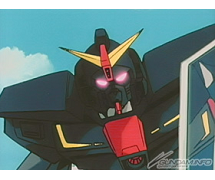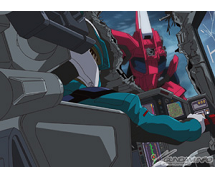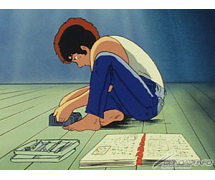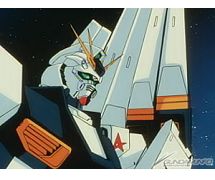8 mai 2013
Gundam School Part 19
SD Gundam Part 3
"What is 'Gundam', anyway?" This simple (?) question is answered in our nineteenth casual weekly column just for new fans!
A 19th super-simple column for new Gundam fans creeps out from the woods at night, leaving mysterious tracks!
Part 1 was Gundam faces and coloring, and then part 2 was masked men and Haro. Part 3 was all about the Universal Century, part 4 was mobile suits, part 5 took on MSVs, and part 6 covered the "Zaku" and "GM", part 7 took on parts swapping, part 8 was an example of mobile suit R&D, part 9 was all about the women of the first Mobile Suit Gundam series, part 10 focused on Gundam's "big brothers", part 11 touched on amphibious mobile suits, part 12 introduced some middle-aged men, and parts 13 and 14 were the first and second parts of our look at Gundam TV themes, parts 15 and 16 took on Gundam's 'Gunpla' plastic models, and parts 17 and 18 began our SD Gundam feature; this week we've got one more really iconic piece of Gundam.
SD Gundam: from hilarious parody to sweeping new stories, from Gashapon toys to BB Senshi models, and as an animation that can hold its own against the rest of Gundam. This week we're visiting the worlds it's created over the course of its later anime series... And maybe a little something extra!
Part 1
What makes an SD Gundam? Characters and settings with their own unique twist, separate from normal Gundam!




The Carddas-centric portions of SD Gundam were made into the four Mobile Suit SD Gundam Gaiden OVAs, released in March, May, and December of 1990 and March of 1991.
SD Gundam Gaiden I: Lacroa no Yusha, ("Hero of Lacroa") set in the Lacroa Kingdom of Saddrac World, chronicles the journey of amnesiac hero Knight Gundam as he and his comrades defend his kingdom from Satan Gundam.
Knight Gundam, questing to rescue Princess Fraw from Zeon's monsters, must pursue a stone tablet stolen by Knight Char (friend, foe, or both?) He's joined in his journey by Knight Amuro, Priest Guntank, Warrior Guncannon, and Forest Fairy GM Sniper Custom. Attacked in a dungeon by a herd of Slime Adzams, but saved in the nick of time by a Pegasus, this mix of SD Gundam characters and RPG tropes brings to mind the simpler times of NES gaming.
In SD Gundam Gaiden II: Densetsu no Kyojin, ("Legendary Giant") Knight Gundam again straps on his sword and shield to do battle with a legendary giant who resurrected the Emperor of Darkness Siegzeon. Its desert setting fits well with a more serious atmosphere.
SD Gundam Gaiden III: Argus Kishidan ("Knights of Argus" tells of Amuro's training journey to the Kingdom of Argus. There, he encounters three feuding knightly orders who lack a single commander (swift riders, doughty warriors, and clever mages) and their leaders (all, of course, Gundams), and takes on that role.
In the conclusion, SD Gundam Gaiden IV: Hikari no Kishi, ("Knight of Light") Knight Amuro, now at the fore of a restored Lacroa's armies, leads the Knights of Argus and a host of other Gundam heroes to a dark parallel world for a final clash with Siegzeon.
This swords-and-sorcery epic is known within SD Gundam Gaiden as the "Lacroa Series" or "Siegzeon Arc".


Mobile Suit SD Gundam Gekijioban: Musha - Knight - Commando SD Gundam Kinkyu Shutsugeki ("the Movie: Musha - Knight - Commando SD Gundam Emergency Scramble") was released in March of 1991 to accompany Mobile Suit Gundam F91 in theaters.
A dimensional portal summons Commando Gundam, Musha Gundam and Knight Gundam to save the world. A Gundam dream team of heroes drawn from different worlds fighting to recover a stolen crystallization of everyone's lives, the perfect concept for a movie, has a major influence on the SD Gundam Force TV series and other later titles.
Paparu no Akatsuki Dai 103-wa: Suginamu no Hanayome ("Dawn of Paparu Episode 103: Bride of Suginamu") was released as an OVA in August of 1993. Set in a fantasy world unlike those of previous SD Gundam titles, this was presented as an episode in a long-running series (that, of course, doesn't actually exist.)


Mobile Suit SD Gundam Matsuri ("Festival") in March 1993 cast Musha Gundam, Knight Gundam, Commando Gundam, and the rest of the SD Gundam heroes in their first-ever solo theatrical appearance.
SD Commando Senki II's "Crushers" and SD Commando Senki III's "Super G-Arms" join up with the Super Knight Final Formula in the aptly-named SD Commando Senki Gundam Force Super G-Arms Final Formula vs. Noumugather; what seems to be a peaceful world perfect for viewing the cherry blossoms is transformed when the Fourth Daishogun reveals his trap in SD Sengokuden Tenka Taihei Arc, and a new battle begins in Saddrac World as the popular Seikihei Monogatari from Carddas is retold in SD Gundam Gaiden Seikihei Monogatari chapters one and two. This three-way lineup was perfect for SD Gundam fans!



Gundam Evolve../14, part of the Gundam Evolve series, tells an original story of SD Gundam Force Emaki Musha Retsuden Bukabuka-hen's Rekka Musha Gundam in 3DCG.
Three boys and a Musha Gundam are relaxing at a teahouse (oh, those cute Haro dumplings) when Mazaku's forces appear.
Gundam Evolve was created to promote Gundam's Gunpla plastic models, but Musha Gundam's dynamic, stylish action stands on its own.


SD Gundam Force, the 25th anniversary Gundam project and the tenth Gundam TV series, was the first Gundam series to be broadcast after Japan's introduction of digital TV.
Intended to bring SD Gundam to America as well, and premiering in the US several months before Japan, it was the first fully-3D animation to be broadcast in Japan. Its technical quality and use of advanced technology was both remarkable and remarked-upon.
The Gundam Force, defending Neotopia where humans and robots live alongside one another from General Zeong and his Dark Axis, is lead by Captain Gundam. The show focuses on his battles and his friendship with the boy Shute, but also includes plenty of references to older SD Gundam titles and the kind of Gundam parody SD Gundam thrives on (check out Chief Haro's sixth sense!) Themes of time and space, as well as time paradoxes, also come into play in this unique world which draws on hard SF for its setting in order to please Gundam fans young and old, veteran and new.


Last but not least, there's SD Gundam Sangokuden Brave Battle Warriors, which began its TV broadcast in April 2010. A 20th anniversary BB Senshi project, it brings the BB Senshi Sangokuden adaption of the Chinese classic Romance of the Three Kingdoms to the screen. SD Gundam characters with a new, Chinese-inspired armor design wage war across a land called "Militia" based on ancient China.
The fourteenth Gundam television series, it was broadcast in 15-minute episodes alongside Sgt. Frog. (It's also the only Gundam series to have episode titles written vertically in Japanese.)
When Lu Zhi GM Cannon's army is attacked, Liu Bei Gundam, wielder of the legendary Dragon Emperor Sword, is told by his master to set out seeking justice. Joined on his journey by Zhang Fei Gundam and Guan Yu Gundam, they swear a lifelong vow of brotherhood. The dashing tale of these brave men is fascinating even if you're not a history buff or Three Kingdoms fan!
SD Gundam Sangokuden Brave Battle Warriors was also released as a short movie titled Chodeneiban SD Gundam Sangokuden Brave Battle Warriors in February of 2010.
Part 2
What makes an SD Gundam? Its own influence on the Gundam legend, and its own generation of fans!

In 2012, the BB Senshi line celebrated 25 years with the Legend BB series of kits.
Chosen from SD Gundam favorites including Musha Gundam, Knight Gundam, and Commando Senki, these revised kits were given expanded stories.
While there was a year or so of a gap in BB Senshi releases leading up to its release, there certainly wasn't much peace and quiet; movement was completely rethought, replacement eye parts for changing expressions were created, kits were completely rebuilt, and even more fun features were added to a series that gave these old favorites the respect they deserved.
Even the box art and illustrations are created by the team of three led by Maestro Yokoi, the father of SD Gundam. These kits are coming out on a regular basis, so if you're curious, check out the BB Senshi 25th anniversary site at http://bandai-hobby.net/BB25/!
And that's all for our 19th column, which covered SD Gundam's journey from its first steps as a standalone franchise to its latest TV series. We also scratched the surface of the new Legend BB kits.
SD Gundam gave the very idea of "SD" its name, and I can't wait to see it continue on alongside Gundam, bringing together generations and eras of fans and Gundams to create new legends.
Oh, isn't Gundam just so fascinating?
Well, well, well, well, well, well, well, well, well, well, well, well, well, well, well, well, well, well, well, that's it for this week. Next week we'll be taking another laid-back look at what makes Gundam Gundam!
by Ema Baba
A 19th super-simple column for new Gundam fans creeps out from the woods at night, leaving mysterious tracks!
Part 1 was Gundam faces and coloring, and then part 2 was masked men and Haro. Part 3 was all about the Universal Century, part 4 was mobile suits, part 5 took on MSVs, and part 6 covered the "Zaku" and "GM", part 7 took on parts swapping, part 8 was an example of mobile suit R&D, part 9 was all about the women of the first Mobile Suit Gundam series, part 10 focused on Gundam's "big brothers", part 11 touched on amphibious mobile suits, part 12 introduced some middle-aged men, and parts 13 and 14 were the first and second parts of our look at Gundam TV themes, parts 15 and 16 took on Gundam's 'Gunpla' plastic models, and parts 17 and 18 began our SD Gundam feature; this week we've got one more really iconic piece of Gundam.
SD Gundam: from hilarious parody to sweeping new stories, from Gashapon toys to BB Senshi models, and as an animation that can hold its own against the rest of Gundam. This week we're visiting the worlds it's created over the course of its later anime series... And maybe a little something extra!
Part 1
What makes an SD Gundam? Characters and settings with their own unique twist, separate from normal Gundam!




The Carddas-centric portions of SD Gundam were made into the four Mobile Suit SD Gundam Gaiden OVAs, released in March, May, and December of 1990 and March of 1991.
SD Gundam Gaiden I: Lacroa no Yusha, ("Hero of Lacroa") set in the Lacroa Kingdom of Saddrac World, chronicles the journey of amnesiac hero Knight Gundam as he and his comrades defend his kingdom from Satan Gundam.
Knight Gundam, questing to rescue Princess Fraw from Zeon's monsters, must pursue a stone tablet stolen by Knight Char (friend, foe, or both?) He's joined in his journey by Knight Amuro, Priest Guntank, Warrior Guncannon, and Forest Fairy GM Sniper Custom. Attacked in a dungeon by a herd of Slime Adzams, but saved in the nick of time by a Pegasus, this mix of SD Gundam characters and RPG tropes brings to mind the simpler times of NES gaming.
In SD Gundam Gaiden II: Densetsu no Kyojin, ("Legendary Giant") Knight Gundam again straps on his sword and shield to do battle with a legendary giant who resurrected the Emperor of Darkness Siegzeon. Its desert setting fits well with a more serious atmosphere.
SD Gundam Gaiden III: Argus Kishidan ("Knights of Argus" tells of Amuro's training journey to the Kingdom of Argus. There, he encounters three feuding knightly orders who lack a single commander (swift riders, doughty warriors, and clever mages) and their leaders (all, of course, Gundams), and takes on that role.
In the conclusion, SD Gundam Gaiden IV: Hikari no Kishi, ("Knight of Light") Knight Amuro, now at the fore of a restored Lacroa's armies, leads the Knights of Argus and a host of other Gundam heroes to a dark parallel world for a final clash with Siegzeon.
This swords-and-sorcery epic is known within SD Gundam Gaiden as the "Lacroa Series" or "Siegzeon Arc".


Mobile Suit SD Gundam Gekijioban: Musha - Knight - Commando SD Gundam Kinkyu Shutsugeki ("the Movie: Musha - Knight - Commando SD Gundam Emergency Scramble") was released in March of 1991 to accompany Mobile Suit Gundam F91 in theaters.
A dimensional portal summons Commando Gundam, Musha Gundam and Knight Gundam to save the world. A Gundam dream team of heroes drawn from different worlds fighting to recover a stolen crystallization of everyone's lives, the perfect concept for a movie, has a major influence on the SD Gundam Force TV series and other later titles.
Paparu no Akatsuki Dai 103-wa: Suginamu no Hanayome ("Dawn of Paparu Episode 103: Bride of Suginamu") was released as an OVA in August of 1993. Set in a fantasy world unlike those of previous SD Gundam titles, this was presented as an episode in a long-running series (that, of course, doesn't actually exist.)


Mobile Suit SD Gundam Matsuri ("Festival") in March 1993 cast Musha Gundam, Knight Gundam, Commando Gundam, and the rest of the SD Gundam heroes in their first-ever solo theatrical appearance.
SD Commando Senki II's "Crushers" and SD Commando Senki III's "Super G-Arms" join up with the Super Knight Final Formula in the aptly-named SD Commando Senki Gundam Force Super G-Arms Final Formula vs. Noumugather; what seems to be a peaceful world perfect for viewing the cherry blossoms is transformed when the Fourth Daishogun reveals his trap in SD Sengokuden Tenka Taihei Arc, and a new battle begins in Saddrac World as the popular Seikihei Monogatari from Carddas is retold in SD Gundam Gaiden Seikihei Monogatari chapters one and two. This three-way lineup was perfect for SD Gundam fans!



Gundam Evolve../14, part of the Gundam Evolve series, tells an original story of SD Gundam Force Emaki Musha Retsuden Bukabuka-hen's Rekka Musha Gundam in 3DCG.
Three boys and a Musha Gundam are relaxing at a teahouse (oh, those cute Haro dumplings) when Mazaku's forces appear.
Gundam Evolve was created to promote Gundam's Gunpla plastic models, but Musha Gundam's dynamic, stylish action stands on its own.


SD Gundam Force, the 25th anniversary Gundam project and the tenth Gundam TV series, was the first Gundam series to be broadcast after Japan's introduction of digital TV.
Intended to bring SD Gundam to America as well, and premiering in the US several months before Japan, it was the first fully-3D animation to be broadcast in Japan. Its technical quality and use of advanced technology was both remarkable and remarked-upon.
The Gundam Force, defending Neotopia where humans and robots live alongside one another from General Zeong and his Dark Axis, is lead by Captain Gundam. The show focuses on his battles and his friendship with the boy Shute, but also includes plenty of references to older SD Gundam titles and the kind of Gundam parody SD Gundam thrives on (check out Chief Haro's sixth sense!) Themes of time and space, as well as time paradoxes, also come into play in this unique world which draws on hard SF for its setting in order to please Gundam fans young and old, veteran and new.


Last but not least, there's SD Gundam Sangokuden Brave Battle Warriors, which began its TV broadcast in April 2010. A 20th anniversary BB Senshi project, it brings the BB Senshi Sangokuden adaption of the Chinese classic Romance of the Three Kingdoms to the screen. SD Gundam characters with a new, Chinese-inspired armor design wage war across a land called "Militia" based on ancient China.
The fourteenth Gundam television series, it was broadcast in 15-minute episodes alongside Sgt. Frog. (It's also the only Gundam series to have episode titles written vertically in Japanese.)
When Lu Zhi GM Cannon's army is attacked, Liu Bei Gundam, wielder of the legendary Dragon Emperor Sword, is told by his master to set out seeking justice. Joined on his journey by Zhang Fei Gundam and Guan Yu Gundam, they swear a lifelong vow of brotherhood. The dashing tale of these brave men is fascinating even if you're not a history buff or Three Kingdoms fan!
SD Gundam Sangokuden Brave Battle Warriors was also released as a short movie titled Chodeneiban SD Gundam Sangokuden Brave Battle Warriors in February of 2010.
Part 2
What makes an SD Gundam? Its own influence on the Gundam legend, and its own generation of fans!

In 2012, the BB Senshi line celebrated 25 years with the Legend BB series of kits.
Chosen from SD Gundam favorites including Musha Gundam, Knight Gundam, and Commando Senki, these revised kits were given expanded stories.
While there was a year or so of a gap in BB Senshi releases leading up to its release, there certainly wasn't much peace and quiet; movement was completely rethought, replacement eye parts for changing expressions were created, kits were completely rebuilt, and even more fun features were added to a series that gave these old favorites the respect they deserved.
Even the box art and illustrations are created by the team of three led by Maestro Yokoi, the father of SD Gundam. These kits are coming out on a regular basis, so if you're curious, check out the BB Senshi 25th anniversary site at http://bandai-hobby.net/BB25/!
And that's all for our 19th column, which covered SD Gundam's journey from its first steps as a standalone franchise to its latest TV series. We also scratched the surface of the new Legend BB kits.
SD Gundam gave the very idea of "SD" its name, and I can't wait to see it continue on alongside Gundam, bringing together generations and eras of fans and Gundams to create new legends.
Oh, isn't Gundam just so fascinating?
Well, well, well, well, well, well, well, well, well, well, well, well, well, well, well, well, well, well, well, that's it for this week. Next week we'll be taking another laid-back look at what makes Gundam Gundam!
[Author profile]
Ema Baba
Scriptwriter. Troublemaking scenarist.
Learning more every day to teach you about the fun of Gundam!
Scriptwriter. Troublemaking scenarist.
Learning more every day to teach you about the fun of Gundam!
PAGES LES PLUS VISITÉES
ARTICLES RECOMMANDÉS
Activez les cookies pour voir les articles recommandés






